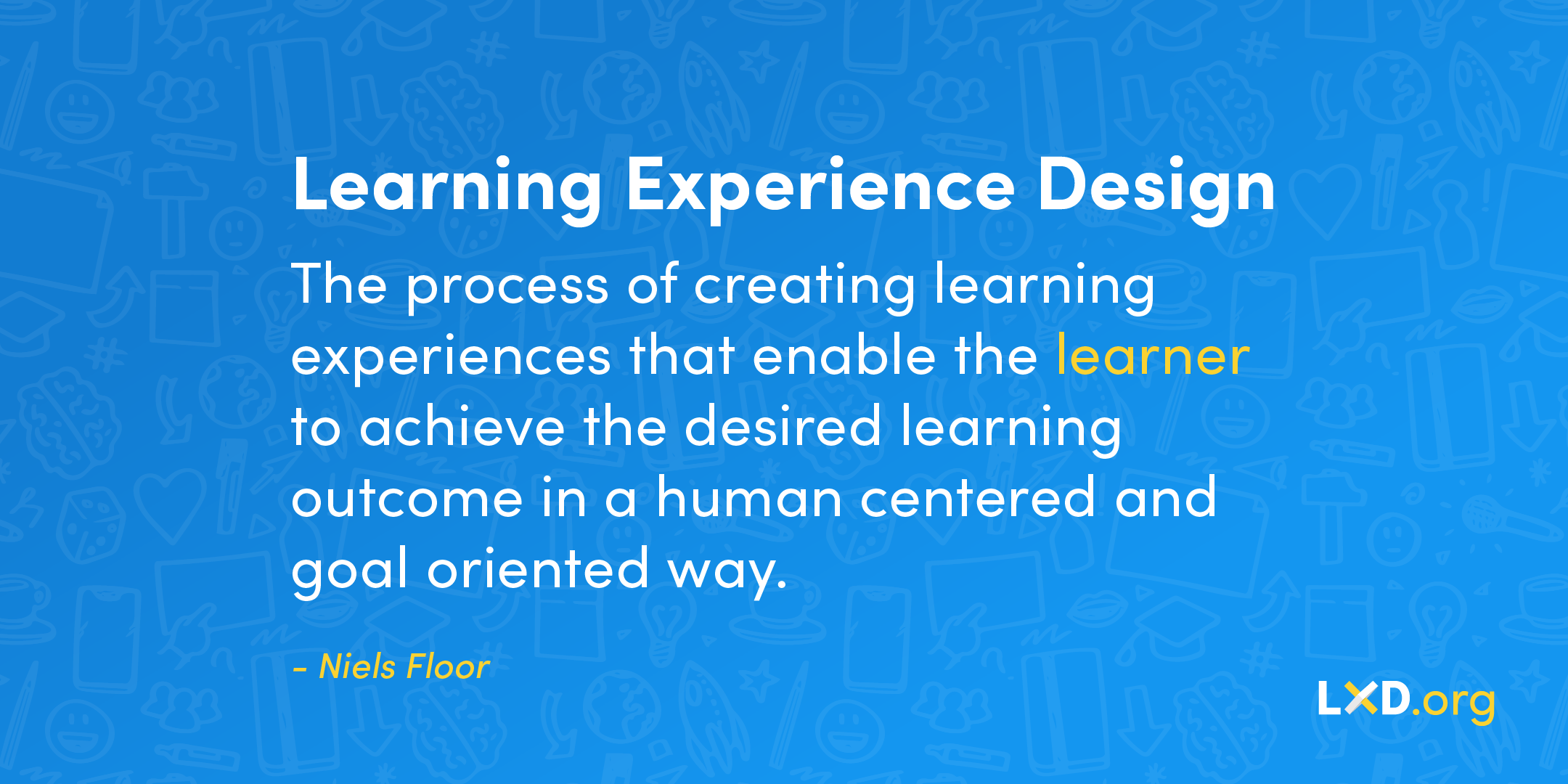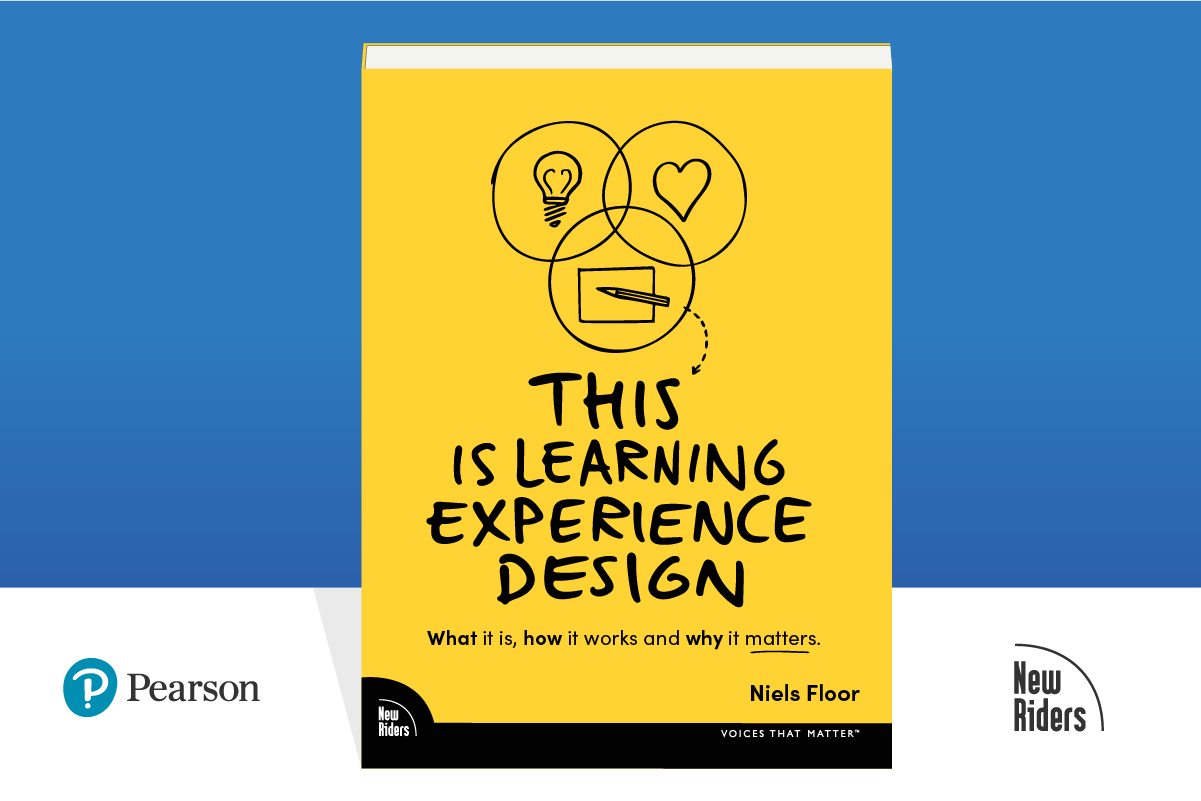What is learning experience design?
Learning experience design is the process of creating learning experiences that enable the learner to achieve the desired learning outcome in a human centered and goal oriented way.
- Niels Floor, This is learning experience design

Learning experience design (LX design or LXD) bridges the gap between creative design disciplines and the field of learning. It offers a refreshing view on how to shape the way we learn by applying the perspective, methods, skills, and tools of a designer.
Key design principles used in LXD come from interaction design, user experience design, experience design, graphic design and game design. These design principles are combined with elements of education, training and development, instructional design, cognitive psychology, experiential learning, educational sciences and neuroscience.
In the video below, LXD pioneer Niels Floor explains what learning experience design is.
To gain a deeper understanding of of learning experience design, let's take a closer look at the definition that you've just read. On the surface, it might seem similar to other approaches. If you are willing to dig deeper, you will discover the unique characteristics of learning experience design and learn how it’s different from any other discipline.
Let's zoom in on the words: learning, experience and design.
First up is experience, which is what LXD is all about.
Experience
Everything we learn comes from experience, that’s a fact. Our lives are a collection of experiences that range from life changing to totally insignificant. We are shaped by these experiences, for better or for worse. While many experiences are easily forgettable, we’ve all had experiences that will stick with us for the rest of our lives. That’s the power of experience! The goal of a learning experience designer (LX designer) is to harness this power and create incredible learning experiences.
The word experience is often associated with doing something spectacular or remarkable, like riding a roller coaster, having a fancy dinner, or driving your dream car. It’s important to know that experiences take place everywhere and happen all the time. Having a conversation with a friend, reading a good book, or playing with your kids are ordinary experiences that can be just as memorable.
"An experience is any situation you encounter that takes a certain amount of time and that leaves some kind of impression." - Niels Floor, This is learning experience design
There are fundamental differences between designing an experience and designing a course, training, or curriculum. An experience goes beyond the content, instruction, exercises, assessments, and tools being used. These can be part of the experience, but they are not the experience itself. Experiences include everything that happens to and around you. They influence what you do, think, and feel. That’s why LXD focuses on the whole experience.
Focusing on the whole experience, requires a more holistic design approach. For example, emotion plays a vital part in how we experience things. We all have memories that are strong because of how they made you feel. In education there tends to be a clear emphasis on cognition while emotion is hardly part of the conversation. In LXD emotion is carefully considered. Designing for emotion and cognition is key to creating a powerful learning experience.
There’s a lot more to say about experience in relation to LXD, to dig deeper you can read “What is a learning experience?” if you haven’t already.
Design
Learning experience design is a creative design discipline. Think about what designers are typically known for:
- Original ideas,
- Unexpected observations,
- Elegant solutions,
- Intuitive designs that are both beautiful and functional.
That’s why designers, LX designers included, are perfectly equipped to come up with and create unique designs that work.
A design consists of many layers. These range from conceptual and abstract to visual, tangible, and concrete. Learning experiences also can come in many shapes and sizes. One moment you work on an e-learning module for employees, the next you are creating a board game for students. This versatility requires a broad range of design skills. As mentioned earlier, learning experience design incorporates aspects of interaction design, user experience design, experience design, graphic design, and game design. Mastering these aspects isn’t easy and requires serious dedication.
Design can be considered an applied form of art. Like paintings are an inspiration to graphic designers, different forms of art are inspiring for LX designers. For example, literature and cinema are inspiring for storytelling while interactive art helps to gain a better understanding of human behavior and decision making.
Learning experience design is not a science. While learning science can support your design decisions, most insights into the quality and effectiveness of your design come from developing and testing prototypes. You refine your design with each iteration as you work towards delivering a learning experience that does what it’s supposed to. This creative process may seem unpredictable at times, but we use design principles that are tried and tested. Like human centered design and goal-oriented design.
Process of creation
Central to the practice of LXD is the creative process. Similar to other creative professions the learning experience design process typically includes research, experimentation, ideation, conceptualization, prototyping, iteration and testing. It is not a linear, systematic, and methodical approach, but an iterative, creative, and exploratory approach. Such an approach is best suited for creating original designs with unique characteristics for a specific group of people in a specific context. This isn’t necessarily the easiest or quickest process, but it is a process that allows you to come up with the best possible designs.
Learning
The purpose of the experience you design is for people to learn from it. There are many ways to learn from an experience, just think about your own experiences. Sometimes everything goes according to plan, and you learn just what you need. Other times making a mistake seems terrible at first but turns out to be very educational. Understanding how we learn from what we experience is essential to design effective learning experiences. That’s why experiential learning in particular is foundational to learning experience design. It explores and explains how human experience is processed. The focus in learning experience design is where it should be: on the learner and the process that the learner goes through.
Traditionally, the learner isn’t the central figure in education. For example, educational publishers generally focus on subject matters experts first. They decide what matters and what doesn’t. Next, they design their materials in a way that makes them appealing for their clients: the schools. When a school purchases materials they want their teachers to be able to work with it. Finally, we get to the student who learns from the teacher. LXD works the other way around: we start with the learner and everyone else is there to support them.
Desired learning outcome
This focus on the learner also applies to the learning outcome. In the definition of LXD at the start of this article a “desired learning outcome” is mentioned. A learning outcome is desirable when it is relevant, meaningful, and valuable to the learner. That’s what’s been missing in more conventional learning where you know what to learn but often not why to learn it. For example, corporate learning can be about increasing profit and return on investment. That’s great for the company but what’s best for the employee? In the end, you want to align the goals of all stakeholders to come to a learning outcome that works for everyone, especially the learner.
Designing a learning experience that enables a learner to reach the desired learning outcome doesn’t happen by accident. It requires an approach that is human centered and goal-oriented.
TIP: Are you looking for a tool that helps define the desired learning outcome and learning objectives? Try the free Learning Experience Canvas!
Human centered
Learning experience design isn’t about teaching, training, or education per se. It’s about the learner, their experience and what they learn from it. We focus primarily on the people who learn, like students, trainees, employees, and clients. Putting the people you design for at the center of your design and your design process is called human centered design. This is an important part of how and why LXD works.
Human centered design comes from user experience design. It is an evolution of user centered design. Providing users with a great user experience is as important as providing learners with a great learning experience. There are key differences though in how to achieve that. Simply put, a user isn’t (always) a learner and vice versa.
TIP: To learn more about the difference and commonalities you can read the blog post: “Human Centered Design for designing great learning experiences.”
As a LX designer you want to get to know and empathize with the people your learner. You want to figure out what drives them, what’s holding them back and how to engage and motive them. That’s why getting in touch with your learners through design research, like in depth interviews, contextual observations and co-creation, is indispensable. These methods are common in the world of design and offer great value in the world of learning.
TIP: A great tool to support human centered design is the free empathy map for learners.
Goal oriented
Choosing and formulating the right goals is a vital step in designing a learning experience. This can be quite a challenge, depending on the scale and complexity of the experience that you are designing. There can be many bigger and smaller goals to keep track of. Applying goal-oriented design helps to focus on the main goals without getting distracted by ideas, activities, content, and features you can add to your design. For example, let’s say you want to design a language learning app. If you keep stacking new features that are supposedly improving the learning experience, you might end up with an over complicated app that is hard to use.
A goal-oriented design approach ensures you see the bigger picture throughout the design process. Using a tool like the Learning Experience Canvas is perfectly suited to support such an approach. It gives a clear overview of all the elements that are part of your design.
An important aspect of learning experience design is choosing the right technology for a learning experience. It's easy to get swayed by the promise of new and innovative technology. Obviously, technology is only a means to an end. Using specific technology isn’t a goal in itself. That’s where goal-oriented design helps to focus on what really matters. The logical thing is to start with formulating the desired learning outcome. Every step that follows in the design process, including the choice in technology, should be geared towards reaching that outcome.
There is overlap between human centered design and goal-oriented design. The methods used to design in a human centered and goal-oriented way are similar, but the focus is different. Keeping the people you design for and their goals at heart will improve every learning experience.

Where it all comes together
LXD is more than a sum of its parts. When you combine the power of experience, the talent of designers, and the focus on the learner their goals something magical happens. That’s where LXD shines as it provides people with memorable experiences that change their lives for the better.
Up Next
How is learning experience design different?
Learning experience design (LXD) is often compared to and sometimes confused with other disciplines like instructional design, user experience design, experience design or design thinking (and the list goes on!) So, how does LXD compare to these disciplines and how is it different?
The fundamentals of LXD

If you want to dig deeper into LXD check out the book: This is learning experience design – What it is, how it works and why it matters by Niels Floor.

